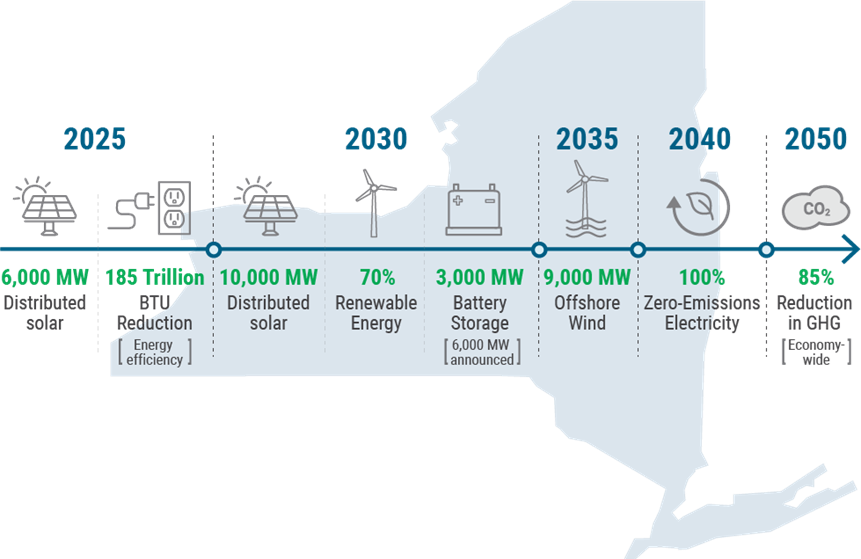New York state is at the forefront of addressing climate change. A decarbonized electric grid is viewed as a driver to broader economy-wide decarbonization through the electrification of transportation, heating, and industry. To this effect, in 2019, New York passed the Climate Change and Consumer Protection Act, which commits the state to achieve 70% of power generation from renewable resources by 2030 and reach 100% decarbonization of the electric grid by 2040, as shown in Figure 1. This transformation of the grid is driving significant changes in market design and resource adequacy calculations to maintain sufficient installed capacity to maintain the high level of reliability that is expected of the electric grid.

Figure 1. New York State Energy Policy Mandates
NYISO Capacity Market

Rana Mukerji
The New York Independent System Operator (NYISO) administers a capacity market to maintain resource adequacy. The capacity market is designed to maintain a planning criterion where the loss of load expectation (LOLE) is better than one occurrence in every ten years. There are three distinct capacity localities in New York in addition to the New York Control Area. The NYISO runs two 6-month strip auctions, 12 multi-month auctions, and 12 one-month spot auctions using a downward sloping demand curve which facilitates price formation and compensates resource providers declining amounts based on the amount of excess capacity. As the proportion of intermittent and energy-limited resources is increasing rapidly, an area of emphasis has been the proper accreditation of capacity, whereby resources are compensated based on their reliability contribution rather than nameplate capacity.
It is imperative for sustaining system reliability to value capacity resources based on contribution to reliability. Capacity markets exist to provide efficient incentives for attracting resources needed to satisfy the resource adequacy requirements of the system. In New York, the installed capacity market has performed this role well and has provided strong signals for developers to make investment or retirement decisions while maintaining a reliable resource fleet. As the resource mix transitions to one more dependent on resources that rely on the sun or wind to produce energy or resources with energy limitations, each resource’s contribution to reliability also evolves. Historically, with central station power generation, each MW of installed capacity could be depended upon for a high degree of availability to provide grid operators with dispatch control to manage transmission constraints. With intermittent and energy-limited resources, this one-to-one relationship between nameplate capacity and expectation of close to nameplate capacity availability on demand no longer exists. The resource adequacy contribution of resources that have limited energy and/or dispatch capabilities, such as being intermittent or having limited energy/fuel storage capabilities, is also very dependent on the diversity and performance of the resource mix. For example, as more solar generation is added to the grid, the net peak load shifts to non-daylight hours, making it less valuable to resource adequacy.
Capacity Market Enhancements
To address these emerging concerns, the NYISO has completed the following market enhancements:
-
- Established a partial capacity value for limited-duration resources: The NYISO established a process for determining the resource adequacy contribution of limited-duration and limited-energy resources with its expanding capacity eligibility construct.
- Improved the alignment of resources’ effective capacity measure (termed unforced capacity (UCAP)) with their reliability contribution: The NYISO established improved methodology and calculations of determining availability factors of intermittent and conventional resources.
The NYISO is building on the enhancements described above to develop a more robust accreditation process that examines the effective capacity contribution of a wide range of resource types. This work draws on effective load-carrying capability concepts which were developed more than 50 years ago and adapts these concepts to a system with a high penetration of renewable and storage resources. The NYISO adopted a marginal accreditation methodology to value and compensate capacity resources.
Capacity accreditation improvements are a necessary response to the clean energy transition. As the supply mix on the grid is evolving more and more rapidly, a proper valuation of the reliability contribution of all capacity resources, particularly intermittent and duration-limited resources, becomes more critical to the proper operation of the capacity market. NYISO and its stakeholders have determined that a marginal accreditation framework that accurately values each resource’s incremental contribution to resource adequacy is the best option for New York.
Marginal accreditation provides the correct market signals for needed investments to maintain reliability and to minimize consumer costs. It will clearly indicate the value of gaining or losing capacity of a resource type, given all the other resources in the system. It therefore accurately signals (a) diminishing returns of resources with correlated availability, and (b) the value of adding capacity of a type that complements other resources in the system and provides a higher marginal reliability contribution. Thus, a marginal framework will encourage investments in new flexible resources when and where needed and incentivize the exit of inflexible conventional resources that cannot help to support intermittent and duration-limited resources from the market. A marginal framework should also achieve the necessary level of reliability at the lowest cost. By contrast, some other regions are pursuing an accreditation methodology based on average accreditation values. However, the use of an average accreditation framework in the NYISO would over-value significant quantities of capacity. The result of such overvaluation would be excessive investment in certain resources—and higher costs—that do not contribute to incremental resource adequacy.
Results of Marginal Capacity Accreditation
Marginal accreditation will result in the compensation paid to a resource participating in the capacity market to be closely tied to the reliability contributions of incremental increases in quantity of this resource. Such marginal accreditation provides the correct market signals for needed investments to maintain reliability and to minimize consumer costs. For intermittent resources such as onshore and offshore wind and solar, marginal accreditation will accurately signal the declining reliability contributions of incremental additions and provide signals when other resource types such as storage may provide more cost-effective incremental reliability contributions. The NYISO’s Market Monitoring Unit (MMU) performed a Consumer Impact Analysis of the Marginal Accreditation approach, which concluded that: 1) a marginal accreditation approach results in more efficient signals for investment and lower consumer costs than the status quo or an average approach, 2) capacity market signals can help guide investment in policy resources at the lowest cost to consumers when renewable energy credits (RECs) supplement wholesale market revenues (i.e., capacity accreditation can guide policymakers to choose the lowest-cost resource mix to achieve the stated policy goals), and 3) efficient accreditation will become more impactful as the New York Climate Leadership and Community Protection Act requires larger quantities of investment.
In my opinion, the NYISO Marginal Accreditation Methodology is a significant market design innovation which positions the NYISO to maintain a high level of reliability at the least cost to consumers.
Rana Mukerji
Senior Vice President, Market Structures
New York Independent System Operator (NYISO)

Leave a Reply